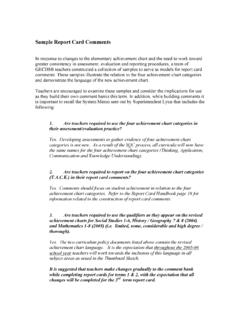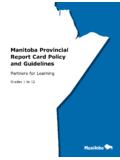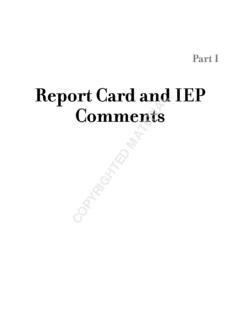Transcription of Report Card Handbook - Spokane Public Schools
1 April 2009 Report card Handbook A Teacher s Guide to Standards-based Grading and Reporting April 2009 Report card Handbook Table of Contents Section 1: Standards Based Grading and Reporting Teaching and Learning Message to Teachers Reporting Purpose Statement Six Principles of Grading Rubric for Grading Practices Tour of the Report card Overview of Content Achievement Criteria for Grading Criteria for Health and Fitness and Fine Arts Criteria for Work Habits Formative and Summative Assessments District Cut Scores Best Practices Modified Grading Section 2: Glossary April 2009 Teaching and Learning Message to Teachers As a teacher in Spokane Public Schools , you are among the most highly skilled professional educators in the nation.
2 Your commitment to continuous learning has created classroom instruction that is world class in every respect. Because you are teaching the district's standards- based curriculum with fidelity, standards-based grading is a natural compliment to the work you are doing in the classroom everyday. The new standards-based reporting system is the result of a request from teachers that the tool used to communicate academic progress to parents is aligned to what is actually taught in classroom instruction. The older Report card was designed before state standards and did not adequately reflect your everyday practice. The new reporting system was designed by practitioners over a three year period that included district-wide feed back on a monthly basis. The draft version of the standards-based Report card was then field tested by 7 pilot Schools during the 2008-09 school year.
3 Teachers from the pilot Schools suggested revisions and those changes have been incorporated into the Report card you see before you. The system for standards-based reporting is research based and grounded by six principles for grading practice. Those principles are outlined in your teacher Handbook . The elementary standards-based reporting committee will continue to meet through the first year of implementation in order to provide support to you and your colleagues. We are confident that the new reporting system will meet the highest standards for accurately communicating student academic progress. Thank you in advance for your commitment to increased academic achievement for each of our students. Karin Short Associate Superintendent Teaching and Learning Services April 2009 Purpose Statement for Standards-Based Reporting The purpose of the Report card is to Report separately: Student achievement based on content standards Student social development and work habits It is important that grades are accurate in describing what students know and are able to do in terms of academic standards.
4 When we include things like effort, participation, or adherence to school rules in grades, grades are essentially broken. To accurately communicate to students and families specific information about achievement, grades must be a pure measure of student achievement. Other behaviors that promote learning like social development and work habits are important, but they need to be reported separately. ~ Spokane Principle 1 - Grades and Reports Should Be Based on Clearly Specified Learning Goals and Performance Standards All 2nd graders in Spokane Public Schools , no matter their school, will be graded using the same standards. Spokane Principle 2 Evidence Used for Grading Should Be Valid Students are assessed on what they are taught. There are no trick questions and no surprises.
5 Spokane Principle 3 Grading Should Be Based on Established Criteria, Not on Arbitrary Norms On a math assessment, students are graded on the math standards assessed, not on arbitrary norms such as poor handwriting or no name on their paper. Spokane Principle 4 Not Everything Should be Included in Grades Your children are not graded as they are learning the information, but after the learning has occurred. Students need to have enough practice in order to be successful in the game. Practice is learning time. (Formative not graded). The game is to show what you know. (Summative graded). Spokane Principle 5 Avoid Grading Based on (Mean) Averages Traditional: Mean Standards-Based: Mode Student 1 Student 2 91 2 91 2 91 3 91 4 91 2 91 4 91 4 70 4 91 4 91 4 889 Mean= Mode=4 Final grade = B Final grade = 4 Spokane Principle 6 - Focus on Achievement.
6 And Report Other Factors Separately Students achievement should be the only aspect included in their grade. Students math grades will reflect their math achievement. However, their work habits and responsibilities during math will be reported separately. SPS Elementary Principles of A Filter for Our WorkApril 2009 Rubric for Grading Practices Criterion Beginning Developing Fluent 1. Organizing the grade book The evidence of learning ( , a grade book) is organized by sources of information ( , tests, quizzes, homework, labs). The evidence of learning ( , a grade book) is organized by sources of information mixed with specific content standards The evidence of learning ( , a grade book) is completely organized by student learning outcomes ( , content standards, benchmarks, grade level indicators, curriculum expectations).
7 2. Including factors in the grade Overall summary grades are based on a mix of achievement and non-achievement factors ( , timeliness of work, attitude, effort, cheating). Non-achievement factors have a major impact on grades. Extra credit points are given for extra work completed, without connection to extra learning. Cheating, late work, and missing work result in a zero (or a radically lower score) in the grade book. There is no opportunity to make up such work, except in a few cases. Borderline cases are handled by considering non-achievement factors. Overall summary grades are based on a mix of achievement and non-achievement factors but achievement counts a lot more. Some extra credit points are given for extra work completed; some extra credit work is used to provide extra evidence of student learning.
8 Cheating, late work, and missing work result in a zero (or lower score) in the grade book. But, there is an opportunity to make up work and replace the zero or raise the lower score. Borderline cases are handled by considering a combination of non-achievement factors and collecting additional evidence of student learning. Overall summary grades are based on achievement only. Extra credit work is evaluated for quality and is only used to provide extra evidence of learning. Credit is not awarded merely for completion of work. Cheating, late work, and missing work is recorded as incomplete or not enough information rather than as zero. There is an opportunity to replace an incomplete with a score without penalty. Borderline grade cases are handled by collecting additional evidence of student achievement, not by counting non-achievement factors.
9 3. Considering assessment purpose Everything each student does is given a score and every score goes into the final grade. There is no distinction between scores on practice work (formative assessment or many types of homework) and scores on work to demonstrate level of achievement (summative assessment). Some distinctions are made between formative (practice such as homework) and summative assessment, but practice work still constitutes a significant part of the grade. Student work is assessed frequently (formative assessment) and graded occasionally (summative assessment). Scores on formative and other practice work ( , homework) are used descriptively to inform teachers and students of what has been learned and the next steps in learning.
10 Grades are based on summative assessments. April 2009 Rubric for Grading Practices Criterion Beginning Developing Fluent 4. Considering most recent information All assessment data are cumulative and used in calculating a final summative grade. No consideration is given to identifying or using the most current information. More current evidence is given consideration at times, but does not entirely replace out-of-date evidence. Most recent evidence replaces out-of-date evidence when it is reasonable to do so. 5. Summarizing information and determining final grade Grade book has a combination of ABC, percentages, + -, and/or rubric scores with no explanation of how they are to be combined into a final summary grade.









